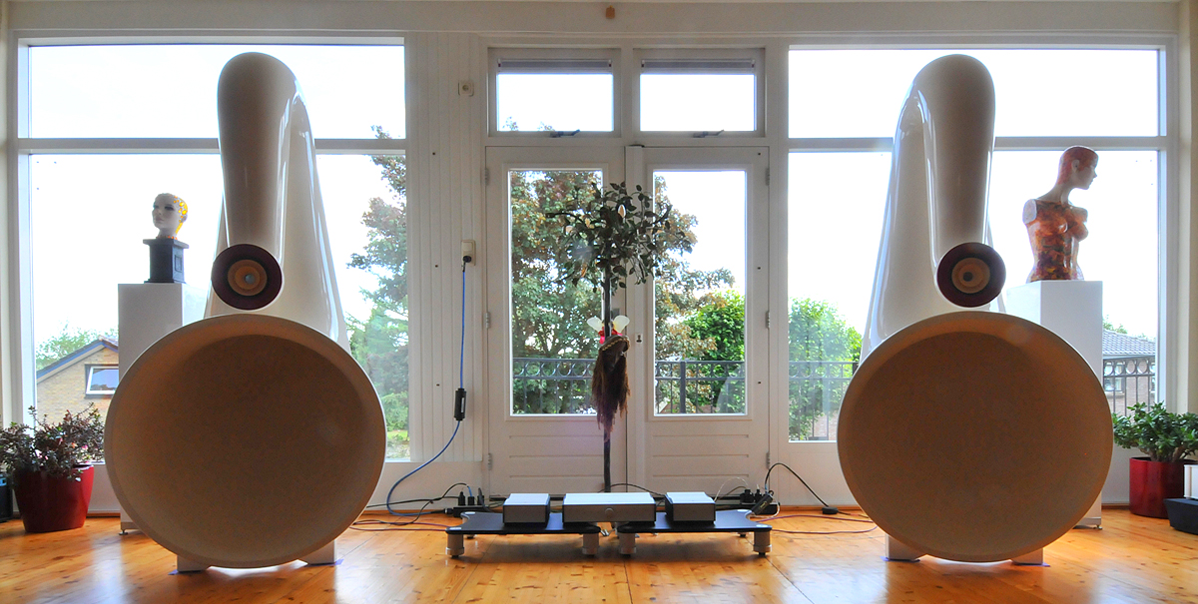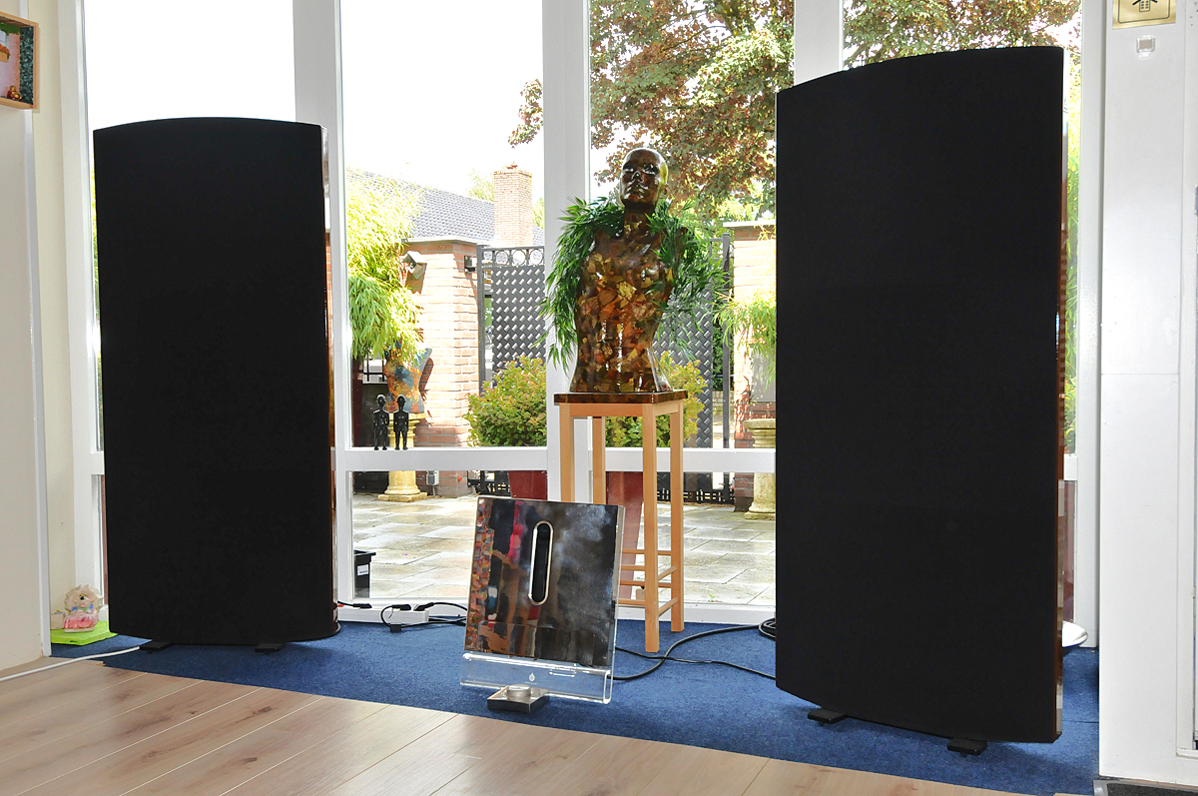 |
|
|
In our upstairs listening room, we readied the following speakers: in the horn category the 100dB/16Ω Arcadian Audio Pnoe and 109dB/16Ω Avantgarde Acoustic Duo Omega; for a more traditional 3-way down-ported dynamic speaker, the 92dB/4Ω Polish Sounddeco Alpha F3. For layered sound we added our Podium Sound One distributed-mode panels whilst we also combined the Alpha F3 with both our Zu Submission subwoofers. Finally we used the literal hole in our floor to connect our downstairs Soltanus Virtuoso ESL to the upstairs Kaluga setup.
|
 |
Music always came from quite a variety of genres. The Complete Alpha Recordings of Christina Pulhar’s L’Arpeggiata and cellist Bruno Cocset with Captain Tobias Hume: Harke! Harke! represented old music. Glenn Gould’s interpretation of Beethoven’s Sonatas for Piano opus 30–33 nicely represented the classic, with N°31 including a prelude to jazz which emerged ‘officially’ some 150 years later.. Henrie Texier was to represent the 1970’s emotive forces of bass and voice on Les Anées JMS. George Dalaras’ Kavafis is a project honouring the Greek poet Cavafy together with large orchestra and choir whilst Nevoa’s Fado Distraido brought a different and fresh view on Portuguese fado to the menu. As we saw, Marciac is a popular live recording venue and Ahmad Jamal Live in Marciac is not only a fine example but the most dynamic recording in a very long time; a must hear. Finally, for some extra though dynamically compressed decibels, Lucky Peterson’s July 28th 2014 Live in Marciac and Larry Carlton & David T. Walker @ Billboard Live Tokyo joined in.
|
 |
Look ma, zero noise on 109dB efficient speakers!
|
| With highly sensitive loudspeakers and 400W/8Ω muscle amps (1’200w/2Ω), attenuation must be steep to save ears and outside birds. Music First’s attenuation transformer secondaries stretch across rather big steps compared to Mola Mola’s Makua which uses a zillion steps for far finer volume tuning options. Hot recordings which mock the red zone on the mixing board are a real PITA in this regard and we tried to avoid them for this review.
|
|
|
|
|
Overall our mantra that Redbook recordings are far from inferior to Studio Quality or Hi Res files still stands after this particular review period. With the Mola Mola Kaluga, any half-decent recording benefited from the utter absence of noise and all interference (with an unprecedented 128dB S/N ratio) whilst the total control which these amplifiers exerted over the connected speakers (output impedance of below 0.002Ω across the audible bandwidth makes for a linear damping factor of 4’000 or more) meant that every single pair of speakers we auditioned straightened up its back to show off in a big way. Differences based on design remained of course—crossover-less single driver versus 4-driver 3-way with crossover, hornloaded versus traditional, super focus versus more diffuse—but again, all of their flavours, loads and dispersion patterns benefited from the compact but potent Dutch power amps.
|
 |
The very best and also shortest way to explain that benefit is to turn the volume down. Playing loud (within reason of course) is easy. The sound blooms and gets most robust. Playing quietly is far harder. Now the sound tends to collapse and wash out. Not with the Kalugas. They enveloped us in an aural illusion with maximum addiction potential. The proof was being able to play at
the lowest perceivable SPL late at night when everything was quiet, even the birds, with our fridge temporarily unplugged to drive down all interior noise to the absolute minimum.
|
 |
Under these most challenging of possible circumstances, the Kalugas still triggered all our emotional sensors. Listening at low volume says so vastly more about a hifi’s true potential than SPL orgies. It also far more convincingly closes the gap between recording and audience. High SPL for serious listening don’t work. They very quickly numb our senses. Getting truly intimate is a matter of nuance and fine cues which attract and repel like turning magnets. That’s when music matters. Here Kaluga proved to be the ultimate go between. Its capabilities to make the air in the room move and excite the ancient ear/brain connection was uncanny; and worked with any speaker we tried. Our time with Kaluga made up for the very long time we waited for Kaluga. Damn was this good! When amplifiers get out of the way like these do, there really is nothing more to say. Anything more would be about added personality and the license of an inaccurate interpreter...
|
 |
 |
Condition of component received: Excellent.
Reusability of packing: Pro-style carrying cases with precision-cut inlays.
Website comments: Could use some attention/updates but offers basic information.
Completeness of delivery: Includes white cotton gloves.
Pricing: €12'000 in the bank today offer an annual 0.7% interest rate whilst inflation in Holland hovers around 1%. A pair of Kaluga thus offers a much higher interest rate to the music lover based on over 20 years of ongoing product development.
|
Publisher's comment: Not all class D amplifiers are recommended for use with electrostatic panels because those can exhibit very high impedance in the treble to cause circuit instability. With their Serbian panel speakers, our writers clearly detected no issues. It's perhaps unexpected that such high-power amplifiers would/should work well on ultra-efficiency loudspeakers like their horns. That these did is a testament to their low noise floor which competes directly with some of the very best current D/A converters. Finally, ultra-low output impedance aka high damping factor can, under certain conditions where a speaker's tuning and/or its low-mass drivers don't need it, overdamp. The fact that Marja & Henk described no such effects suggests that either none of their speakers were of the 'wrong' type—though particularly the AER widebander in their Greek Pnoe horns would have suggested such a one—or that the linearity of Mola Mola's low output impedance manifests differently than the norm. Either way and everything considered, this circuit design seems to rewrite a number of expectations. Are these monos an example then of a perfect power amp? They certainly seem to come as close as current technology would allow, hence our award credit and question mark. For more thoughts on this subject, click here - Ed
|
 |
|

|
|
|

|